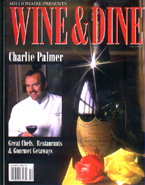

 |
 |
INN AT LITTLE WASHINGTON A NATIONAL TREASURE by Kaya Morgan
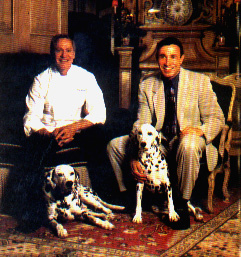 Set amidst the picturesque Virginia countryside between the luminous foothills of the Blue Ridge mountains and the gentle farmlands of the Shenandoah Valley, slightly over an hour leisurely drive from our nation’s capital, is a historic landmark that epitomizes the height of exquisite hospitality and full-flavored new American haute cuisine. Surveyed by George Washington in 1749, the entire area has been declared a national historic district.
Set amidst the picturesque Virginia countryside between the luminous foothills of the Blue Ridge mountains and the gentle farmlands of the Shenandoah Valley, slightly over an hour leisurely drive from our nation’s capital, is a historic landmark that epitomizes the height of exquisite hospitality and full-flavored new American haute cuisine. Surveyed by George Washington in 1749, the entire area has been declared a national historic district.
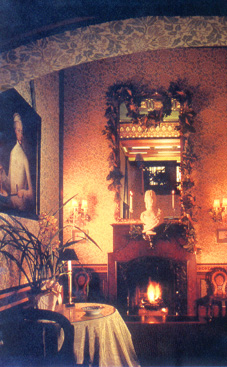 Starting the business in 1972 by catering from their farm house and cooking only with a wood-burning stove and electric frying pan, proprietors Patrick O’Connell and Reinhardt Lynch had no idea where their creativity might take them. The next step in 1978 was to a 100-year-old building that had first been a general store, followed by a gas station and garage. That small restaurant, of humble beginnings from that renovated garage, has successfully earned a devoted following frequented by the very best of Washington’s upper echelon.
Starting the business in 1972 by catering from their farm house and cooking only with a wood-burning stove and electric frying pan, proprietors Patrick O’Connell and Reinhardt Lynch had no idea where their creativity might take them. The next step in 1978 was to a 100-year-old building that had first been a general store, followed by a gas station and garage. That small restaurant, of humble beginnings from that renovated garage, has successfully earned a devoted following frequented by the very best of Washington’s upper echelon.
 With just fourteen bedrooms and suites and a state-of-the-art newly-renovated kitchen, the Inn at Little Washington gives you the feeling of being a welcomed guest in a private home from a bygone era — the epitome of country elegance, yet with all the services, amenities and stellar cuisine of a world-class hotel. Perhaps that is why it is, without a doubt, the hotel and restaurant of choice for many high profile, "movers and shakers" in our country’s elite political arena.
With just fourteen bedrooms and suites and a state-of-the-art newly-renovated kitchen, the Inn at Little Washington gives you the feeling of being a welcomed guest in a private home from a bygone era — the epitome of country elegance, yet with all the services, amenities and stellar cuisine of a world-class hotel. Perhaps that is why it is, without a doubt, the hotel and restaurant of choice for many high profile, "movers and shakers" in our country’s elite political arena.
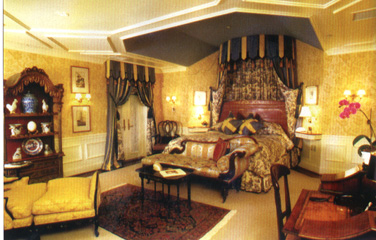 O’Connell and Lynch have spun their fantasy creation so successfully that The Inn at Little Washington has consistently won almost every culinary and hospitality award in America, scoring only the highest ratings in all categories with accolades from almost every food critic in the nation. So incredibly popular, it is sometimes difficult to get reservations. Some nights, they receive as many as 3,000 requests for reservations as the ever-remarkable Scott Little, the general manager, ensures that everyone is successfully accommodated.
O’Connell and Lynch have spun their fantasy creation so successfully that The Inn at Little Washington has consistently won almost every culinary and hospitality award in America, scoring only the highest ratings in all categories with accolades from almost every food critic in the nation. So incredibly popular, it is sometimes difficult to get reservations. Some nights, they receive as many as 3,000 requests for reservations as the ever-remarkable Scott Little, the general manager, ensures that everyone is successfully accommodated.
A stunning combination of the jewel-like living room envelopes you with a 400-year-old parquet de Versailles oak flooring from France, richly-colored, fabric-draped walls and tent-like ceilings, as the inn titillates a bewitching extravagant interior. The guestrooms and suites are extremely tasteful, reflecting the Old World ambiance of a country inn. Each is an original design with plush, king-size beds, overstuffed sofas or lounges, thick, over-flowing draperies and elegant marble bathrooms.
 The 80-seat dining room is decorated with lush exotic, layered fabrics in a colorful array of patters, with rose-colored romantic, silk-fringed lampshades, "floating" above each table. London set designer, Joyce Evans, has combined fine art and period antiques to create a truly sumptuous yet comfortable environment.
The 80-seat dining room is decorated with lush exotic, layered fabrics in a colorful array of patters, with rose-colored romantic, silk-fringed lampshades, "floating" above each table. London set designer, Joyce Evans, has combined fine art and period antiques to create a truly sumptuous yet comfortable environment.
Chef, Patrick O’Connell, has been referred to as "the Pope of American Cuisine" and is considered one of the top chefs in the world today. Self-taught, his culinary wizardry and use of innovative techniques attracts devotees from near and far for a gastronomic journey, described by critics as "so good it makes you cry." O’Connell’s expertise marries local ingredients and traditional recipes with French technique and conceptual rigor.
 House specialties include chilled goose foie gras with rhubarb Riesling sauce and fleur de sel; boudin blanc on sauerkraut braised in Virginia Riesling; seared duck foie gras on polenta with country ham and huckleberries; or local rabbit braised in apple cider with wild mushrooms and garlic mashed potatoes. The selections presented definitely have every palate considered. Desserts present almost impossible choices, and the 15,000-bottle wine cellar boasts some of the best vintners in the world.
House specialties include chilled goose foie gras with rhubarb Riesling sauce and fleur de sel; boudin blanc on sauerkraut braised in Virginia Riesling; seared duck foie gras on polenta with country ham and huckleberries; or local rabbit braised in apple cider with wild mushrooms and garlic mashed potatoes. The selections presented definitely have every palate considered. Desserts present almost impossible choices, and the 15,000-bottle wine cellar boasts some of the best vintners in the world.
The celadon-hued, whimsical "Monkey Lounge" just off the main lobby is perfect for sipping cocktails in stunningly furnished in 19th-century singerie style, with rattan chairs, and hand-painted, trompe l’oeil walls and ceiling by artist Dana Westring showing murals of ivy and monkeys at play. Guests can enjoy an after-dinner drink along with a fine cigar from the humidor. And, don’t miss afternoon tea delivered to your room with a flask of port, sweet biscuits and almonds. Is there anything they haven’t thought of? Doubtless.
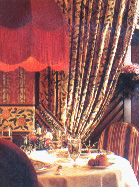 However long it may take, a visit to this magical place with its award-winning history will be memorable — beyond your wildest expectations.
However long it may take, a visit to this magical place with its award-winning history will be memorable — beyond your wildest expectations.
Filet Mignon of rare Tuna capped with Seared Duck Foie Gras
on charred Onion with a Burgundy Butter Sauce
Tuna lends itself very well to some of the same methods of cooking as beef. Blindfolded, this preparation could confuse a cowboy into thinking he was biting into a succulent steak.
A center cut portion of tuna is trimmed to resemble a filet mignon of beef, grilled rare, toped with a slab of seared, fattened duck liver (foie gras) and sauced with an explosively, full-bodied red wine sauce. It’s served resting on charred onions and ribbons of zucchini an carrot. Naturally, the same concept works beautifully with a filet of beef. If foie gras is unavailable, just omit it. The dish will still be sensational without it. You can also make tuna cakes or tartar from the tuna trimmings.
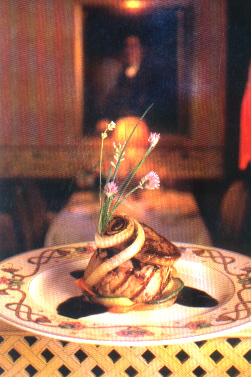 Ingredients:
Ingredients:
4 six oz. center cut, tuna steaks trimmed into the shape of filet mignons
4 ounces of duck foie gras
1 very large white onion, peeled and sliced 1/4 inch thick
2 large carrots, peeled and sliced very thin lengthwise into ribbons
2 medium zucchini, unpeeled and sliced very thin lengthwise into ribbons
2 tablespoons brown butter
Salt, pepper to taste
4 tablespoons olive oil
To Prepare:
Heat a heavy, cast iron skillet over high heat until very hot. Peel and slice the onion into 1/4 inch slices. Moisten the onion slices with olive oil and lay in the hot skillet one layer deep. Cook until lightly charred, turn over with tongs and char the other side. Repeat until all of the onions are cooked. Remove from pan and keep warm.
Meanwhile, bring about 2 qts. of lightly salted water to a rapid boil and drop in the carrot ribbons. Cook about 2-3 minutes until carrots are tender but still "al dente." Lift the carrots out of the water with a slotted spoon or Chinese dipper and place in a bowl. Using the same pot of boiling water, repeat this process with the zucchini ribbons. Note: The zucchini will cook much faster than the carrots. Add cooked zucchini to bowl with carrots. Season vegetables with the brown butter, salt and pepper.
Using a very sharp knife dipped in warm water, slice the liver into 1/2 in. thick dices. Sprinkle with salt and pepper and keep chilled. Moisten the tuna filets with olive oil and season with salt and pepper. Place the tuna steaks on a charcoal grill or into the same hot skillet used to char the onions. Sear the tuna about 2 minutes on each side. Remove and keep warm. In a smoking hot 7" sauté pan, scar the liver slices on both sides for about 30 seconds or just until a crisp outer crust forms. Remove and keep warm.
To Plate:
Quickly lay about 3 or 4 charred onion rings in the center of each of 4 warm serving plates. Arrange 2 slices of cooked carrot and 2 slices of cooked zucchini over the onion in a circular nest-like pattern. Place the hot tuna steak on top. Top with a piece of the cooked duck liver and a few remaining charred onions. Sauce the plate with 3 pools of the Burgundy butter sauce.
Burgundy Butter Sauce:
1 1/8 c. red wine
1 shallot, cut in half
I c. balsamic vinegar
1/8 lb. sweet butter, cut into 4 pieces
1/4 lb. salted butter, cut into 8 pieces
Combine balsamic vinegar, red wine and shallot in a heavy-bottomed saucepan and reduce to a syrupy consistency. Using a wooden spoon, slowly incorporate cold butter into vinegar reduction, one piece at a time. (As one pat of butter is incorporated, add another until all the butter is used up.) Remove shallot and adjust seasoning. Keep in a warm place until ready to serve.
For reservations contact 540.675.3800 or at www.relaischateaux.fr

All Rights Reserved ©
Press Coverage | VentureCapital | Business Development | Venture Opportunities | Resources | Contact Us | Investor Extras | Home